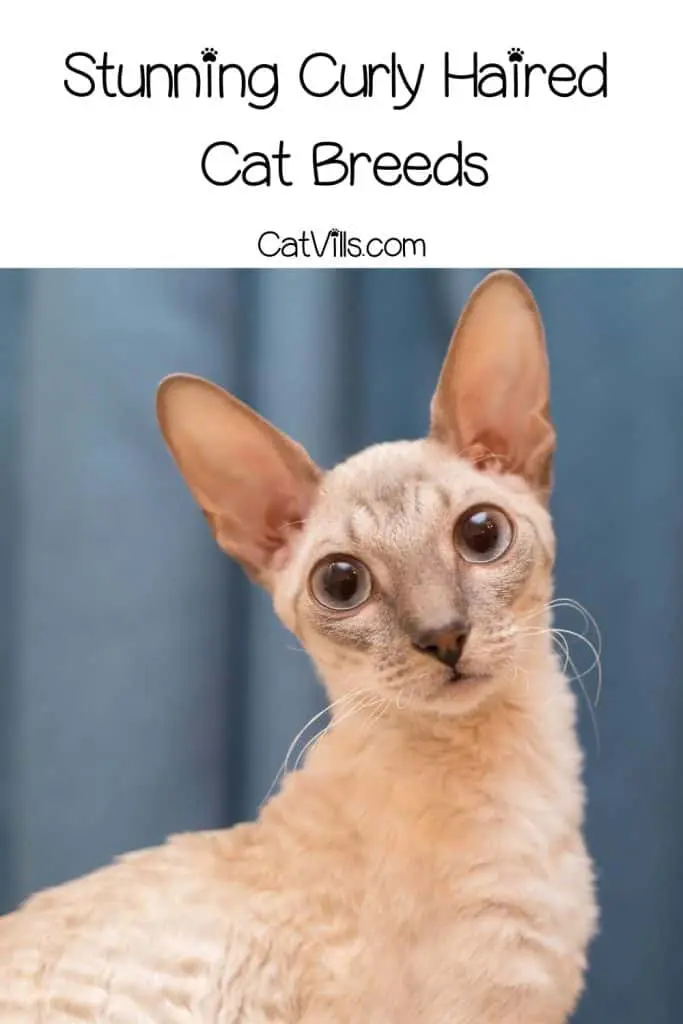Last Updated: 1 year ago
Have you ever wondered why some cats have short, straight coats while others have cute curls?
The answer is simple: a spontaneous genetic mutation called the rex mutation.
This mutation occurs in other mammals besides cats, such as dogs, horses, rats, and rabbits. It causes changes in the structure of the hairs and the cross-section of individual hairs, resulting in soft, curly fur.
Breeders have identified several rex mutation genes in cats: r (Cornish Rex), gr (German Rex), re (Devon Rex), RO (Oregon Rex), LP (LaPerm), and SE (Selkirk Rex).
Each genetic variant leading to a rexed coat can influence the formation of distinctly unique types of curls, which is why rexed cats can vary considerably in appearance.
So, depending on the mutation responsible, the cat’s coat can be wavy, curly, short haired, or long haired, among a few others, which is still pretty rare.
Breeders have much to learn about these mutated genes because of the many variables. New rex mutations can appear in freely bred cats to complicate matters.
Interestingly, another genetic mutation is also why cute cat breeds with folded ears, such as the Scottish Fold, exist.
Cat Breeds With Curly Hair
Unlike short or long-haired coats, curly hair in cats is a rare trait, appearing only in a handful of breeds.
Cat organizations and associations recognize only four curly-haired cats: LaPerm, Devon Rex, Cornish Rex, and Selkirk Rex.
However, several other new or experimental cat breeds have curly hair. The following includes 10 cat breeds with curly hair:
#1 Devon Rex

At first glance, the Devon Rex appears slender and fragile, but these medium-sized cats are agile and muscular.
The Devon Rex goes back to 1959, when a stray cat gave birth to an unusual curly-haired kitten in Devon, England.
At first, people thought the kitten was a Cornish Rex because of its unique appearance. However, genetic tests proved that this was a brand new coat mutation.
Kirlee became the founder of the Devon Rex breed, named after its hometown. 20 years later, the Cat Fancier’s Organization recognized the Devon Rex as a separate breed.
And it’s no wonder people fell in love with the Devon Rex. Their appearance: high cheekbones, large, erect eyelashes, and piercing, oval-shaped eyes.
As for personality, the Devon Rex is also a people-oriented cat who loves to perch on your shoulder, follow you around the house, and be involved in everything you do.
Devon Rex cats are intelligent and learn quickly how to play with puzzle toys or manipulate you into feeding them a tasty treat.
If you don’t mind someone climbing up your shoulders, sneaking into your bed, or begging at the table, the Devon Rex will be the perfect choice for you.
#2 Selkirk Rex

The Selkirk Rex is a sight to behold with its wooly-like curls, heavy-set body, curly whiskers, and dense long or short-haired coat.
The origins of this curly-haired cat breed go back to Montana, USA, when a cat in a shelter gave birth to six kittens, one of which had unusual curly hair.
This female kitten quickly got the attention of Persian Breeder Jeri Newman, who adopted the kitten and named it Miss DePeston.
Once Miss DePesto gave birth to kittens, three of the litter had the same unique curly hair. It turned out that this genetic trait was dominant, not recessive, as in other cats with curls.
The Selkirk Rex’s fluffy coat is also quite different from the Cornish or Devon Rex’s curls. It’s dense and thick, requiring frequent brushing to prevent mats and tangles.
This curly-haired cat is also less active and energetic than its curly cousins. Instead, it has the calm demeanor of Persians and British Shorthair, making it perfect for busy people.
As you can see from this video, Selkirk Rex kittens are born curly.
However, as vets from PetHealth explain, “Selkirk kittens are born with curly coats, but when they reach about 6 months of age, they lose their curls and grow a thin straight coat.”
But don’t panic when your Selkirk Rex loses its stunning curls – they’ll return once the cat matures!
#3 Cornish Rex
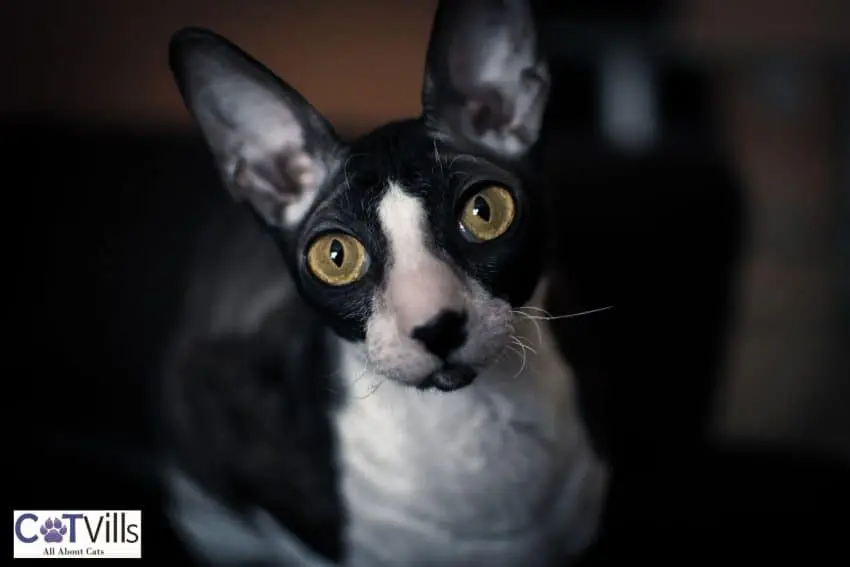
At first glance, it’s easy to confuse Cornish Rex and Devon Rex, thanks to their curly coats. However, the Cornish Rex appeared 10 years before the Devon Rex, and their coats are very different.
The story goes back to Cornwall and a domestic shorthaired tortoiseshell cat that gave birth to a kitten with a curly coat.
The owner, Nina Ennismore, tried to reproduce this trait with moderate success.
Later, the breed was exported to the USA, where breeders used Siamese cats to develop it. The birth of two curly-haired kittens in Germany also helped keep the breed alive.
Unlike the Devon Rex, Cornish Rex cats don’t have guard hairs, the coarse hair that protects the cat’s body from cold or wetness. That’s why many describe the Cornish Rex’s coat as velvety.
The Cornish Rex has a dog-like personality; this is a cat willing to retrieve toys, learn to walk on a leash, and master tricks.
It’s much more energetic than its cousin, almost as vocal as a Siamese, and quite playful.
Interestingly, some Cornish Rex kittens go through a straight coat phase before their mature wavy coat appear.
The Cornish Rex’s coat comes in a wide variety of color combinations and patterns, almost as many as British Shorthair cat colors. And it’s one of the smallest cat breeds in the world!
#4 LaPerm

LaPerm is another cat with curls boasting an exciting history. In the 1980s in Oregon, a barn cat gives birth to a strange bald kitten with big ears and tabby markings.
After a while, the kitten’s coat started to develop, and it turned out to be curly. That’s why the owner named this female kitten Curly.
Curly had her kittens, which were also curly, showing that this new coat mutation was dominant. Twenty years later, the International Cat Association recognized this breed as LaPerm.
Unlike some of its cousins, the LaPerm is a small cat, weighing up to eight pounds. Its bouncy curls, ruffed neck, and long, curly whiskers give it a distinct appearance.
Some owners describe it as clownish and mischievous because the LaPerm can learn to open doors and loves sweeping objects on the floor.
LaPerm cats are quite affectionate, gentle, and well-behaved.
#5 Skookum
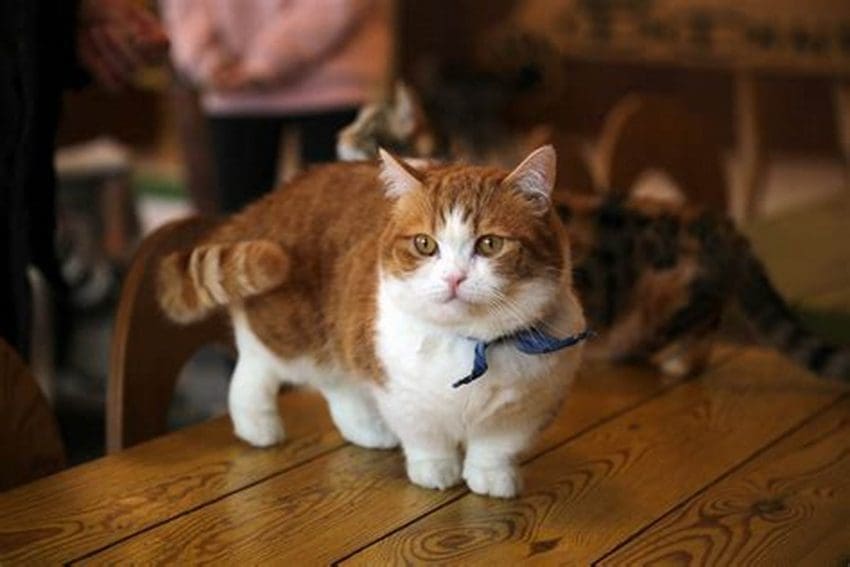
The Skookum is a hybrid breed—a cross between Munchkins and LaPerm cats. It has been around for about 30 years since the breeder Roy Galusha started cross-breeding these two.
The Skookum takes its small body and short legs from its Munchkin parent and its loose curls from the LaPerm, making it one of the cutest dwarf cat breeds.
The Skookum can be as energetic as Munckins or silly as LaPerm cats. But all Skookum cats are affectionate and sweet-natured.
However, since Skookum is still a new breed, there’s much we don’t know about possible health issues.
#6 Oregon Rex
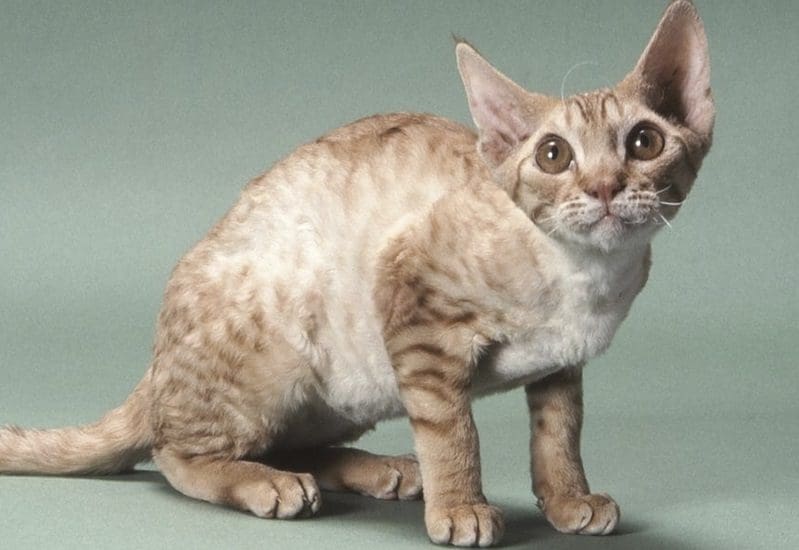
Don’t be surprised if you’ve never heard about the Oregon Rex. It’s the only domestic cat breed that has gone extinct.
The Oregon Rex’s history goes back to the 1940s, making it one of the first curly-haired cat breeds. It quickly gained popularity thanks to its unique appearance.
When breeders imported the Cornish Rex to the USA, they bred it with the Oregon Rex to continue to produce curly-haired kittens.
Unfortunately, breeders lost interest in the development of the Oregon curly hair cats, and the breed merged with Cornish and Devon Rex.
#7 Tennessee Rex
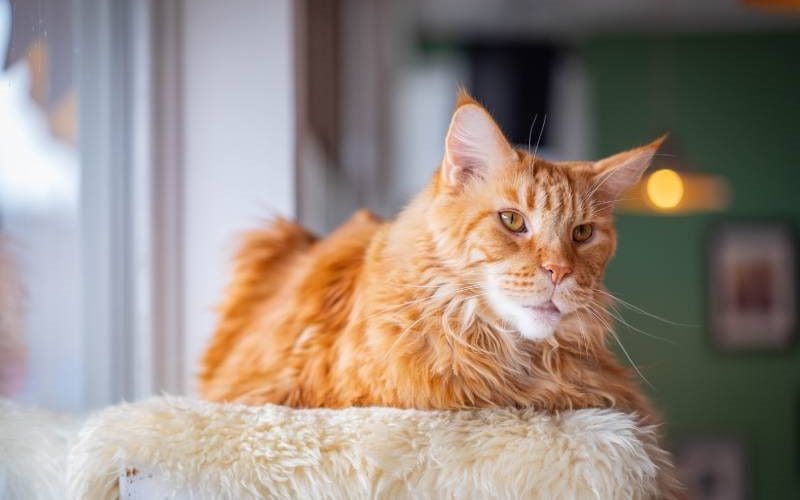
Among all curly-haired breeds, the Tennessee Rex breed stands out with its stunning shimmering coat, usually orange or red or white.
Its history began in 2004, when Franklin Whittenburg adopted a stray cat that soon gave birth to a litter of kittens.
Imagine the cat owner’s surprise when he discovered that two kittens had unusual characteristics: curly, satin-like hair. Genetic testing proved that the cause was recessive genetic variation.
The Tennessee Rex is intelligent, affectionate, and loves being the center of attention.
They’re relatively quiet and make excellent companions for people in love with curly-coated cats. The Tennessee Rex’s dense coat shimmers.
#8 Ural Rex
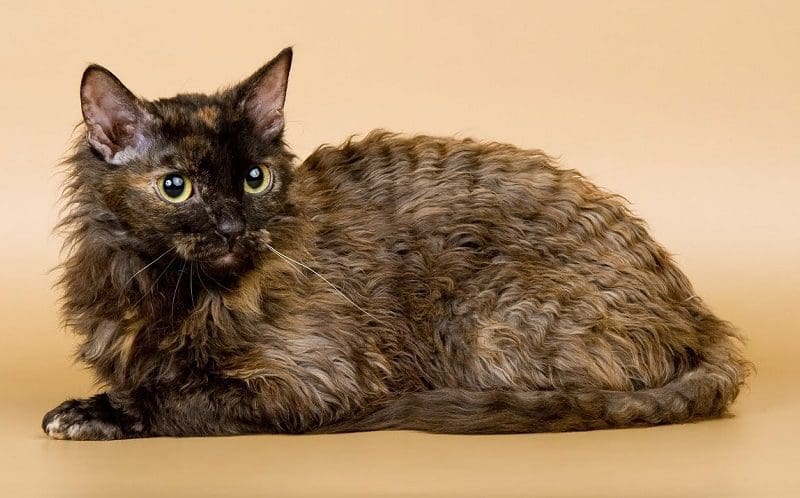
The Ural Rex is one of the rarest cats with the Rex mutation. It has a tight curl coat, short or medium length, a muscular body, and piercing eyes.
This curly-haired cat comes from Russia and the Ural Mountains, hence its name.
While curly cats were common in that region as far back as the 1940s, the breeding program started in the late 1980s.
Like many curly-haired cat breeds, the Ural Rex has a sweet temperament, a playful nature, and a friendly disposition.
And female Ural Rex cats are attentive mothers.
#9 Tasman Manx
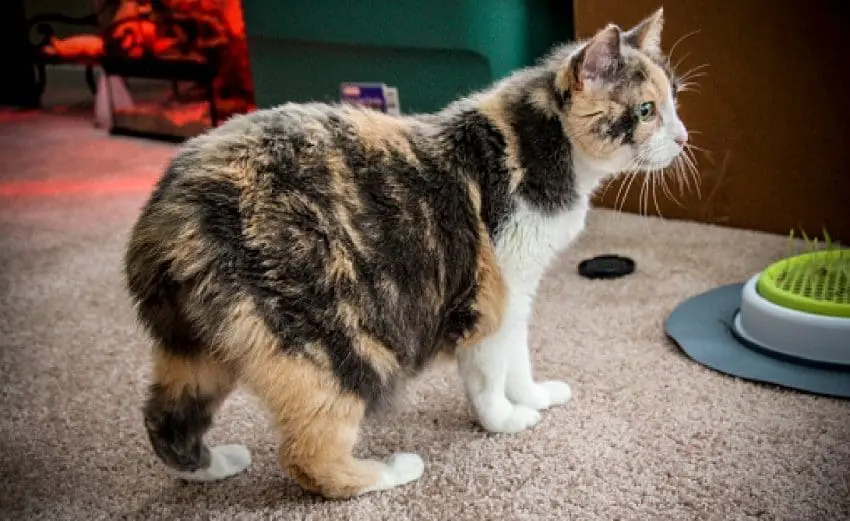
The Tasman Manx has a tightly curled coat (short or longhaired) with a stubbed tail or no tail.
It’s a type of Manx cat bred in Australia and New Zealand.
Tasman Manx have a typical Manx personality: social, affectionate, and shy around strangers.
It doesn’t mind being alone, so this curly-haired cat is perfect for busy families.
#10 German Rex
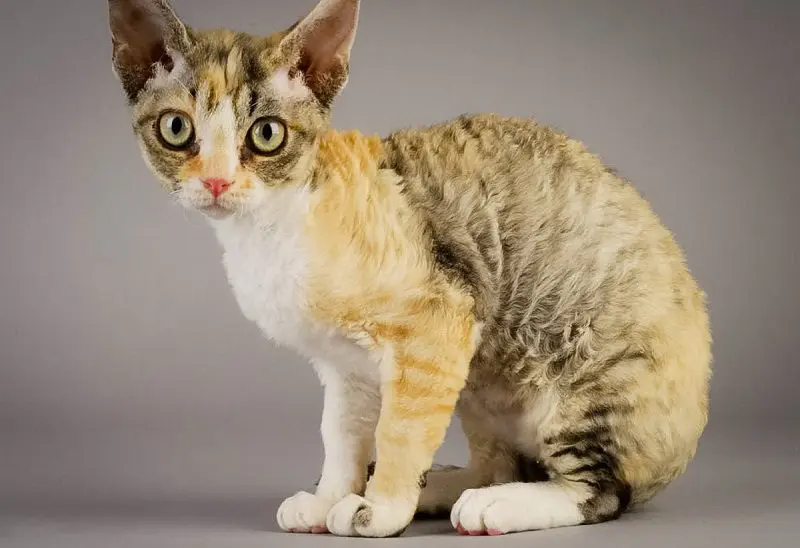
We don’t know much about the German Rex’s roots.
Its history goes back to a stray cat with wavy hair found living in a hospital’s basement in East Germany.
Nowadays, German Rex cats are rare, but people like them for their plush, wavy coats, sleek bodies, and intelligence.
However, the German Rex doesn’t like to be alone and prefers to be involved in family businesses.
How to Get a Curly Cat Breed
So, you’ve fallen in love with a curly cat and want to adopt one. But where can you get one?
Adopt
Check out your local shelters and rescue organizations.
As I already said, the rex mutation appears spontaneously in domestic cats, so it’s possible to find stray or feral cats with curly hair.
You’ll have to pay an adoption fee, but it will be much cheaper than buying a pedigree cat.
Official Breeders
Getting your curly-haired kitten through an official breeder ensures you get a healthy cat:
- Audrey Devon Rex Cattery has available Devon Rex kittens for $800 and ships worldwide
- Royally Purrfect offers Cornish Rex kittens, Russian blue, and Scottish Fold
- Nite Wind Selkirk Rex has available pet Selkirk Rex kittens ($800.00–$1,600.00) and Show Selkirk Rex kittens ($1,500.00–$2,500.00)
How to Care for Cats with Curly Hair?
Cats with curly hair don’t have any special grooming needs. It would be best if you brushed the curly coat gently and regularly.
LaPerm and Selkirk Rex are slightly more difficult to groom because their coats are dense, thick, and prone to mating. You must pay special attention to the neck, abdomen, and limbs.
Cornish and Devon Rex have such a fine coat, so you must be gentle to avoid tearing the hair shaft. And keep an eye for bald patches.
Besides grooming, you should bathe curly-haired cats when their coat becomes oily and greasy. Use gentle products to avoid irritation.
FAQs
Are curly cats rare?
Curly cat breeds are rare because they result from a spontaneous genetic mutation, and cat organizations recognize only four of them.
Are curly-haired cats hypoallergenic?
Curly-haired cats shed less than cats with straight coats, which is why some people consider them hypoallergenic cat breeds.
Conclusion
Curly-haired cat breeds are sweet, affectionate, and energetic. They make excellent companions and can entertain you for hours with their antics.
Most curly-haired cats bond strongly with their owner, so they’re perfect if you want a cute kitty to keep you company or an intelligent cat breed to train.
What do you think about these 10 curly-haired cat breeds? Which one is your favorite? Share your opinion in the comment section.
